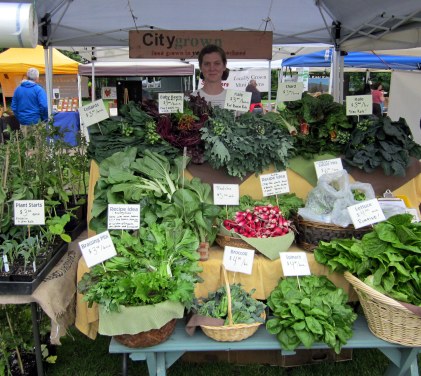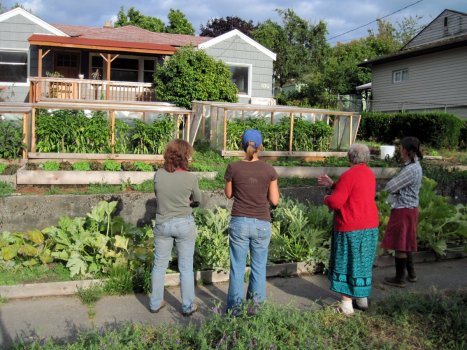What I am Learning: Continual Improvement
Original post: http://wp.me/p1frxx-29G
City Grown Seattle’s first “real” year in business included a lot of learning, adapting, and improving. As the year nears its close, I am left thinking about the things we did well and the things we can adjust and further improve in 2013.
Starting up this year was a huge challenge. It took a lot of time and mental and physical energy from all three of us running the business when everything was new and untested. It’s incredible to think about how much easier it will be this coming winter when we don’t have to triple our land area and clear all that sod. We don’t have to spend time designing and building infrastructure — our tiny greenhouse and collapsible bean trellis system will last at least another couple seasons. We have established our basic markets, so we don’t have to deal with those nagging worries about whether folks will come to our farmstand or whether we will look ridiculous with only a tiny amount of produce at the farmers’ market. Seemingly, all we have to do is order seed and plant, and we will be off and rolling on another successful season.

City Grown’s processing area being used for salad mix. Next year we are ready to graduate from the hand-spinning of mesh laundry bags full of greens.
But, of course, we want to do it better next time around. We want to be able to grow more produce, higher quality produce, and be able to pay ourselves better for our work next year. We want to get more people involved on the farm and get more people eating our food. We want to have food available earlier and later in the season, and grow more of the things that sell well and earn us a high value per square foot. This season is barely winding down and I’m already getting excited thinking about ways to push and challenge ourselves to do better next season.
There are plenty of things I know we can do better based on what we learned this year. There were so many points in time throughout the summer that Noe or Scott and I would say to each other, “well, chalk that one up in the know-for-next-year column!” I’m sure every farmer feels this way after every season — “If only I’d known back in April what I know now!” But we will know it for next April. Next year, we will plant three rows of carrots per bed instead of two. Our method of planting salad mix will change too. I’ll seed the fall cauliflower a couple weeks earlier, and churn out more lettuce successions closer together in the height of summer. Our processing area could improve a lot with the acquisition of a certified scale and a salad spinner — things we will actually have the money to buy next year.
But those ideas are just the easy, obvious ones. There are more that we can come up with by examining the planting, harvest and sales data that we did a pretty good job of collecting over the season. Some number crunching will reveal which crops made us the most and least profit, and hopefully by combining that info with data about how long the plants were in the ground and how much space they took up, we can determine which crops to eliminate and which to grow more of for next year. Of course some of these decisions could be made based on feel (we were there all season, we can guess who was a best seller and who took too much work to grow with measly return on investment) but I think it’s important to look at the hard numbers to back up our gut feelings.

Scott harvesting fall beets; lettuce and broccoli in the background. How can we plan for more yield out of each one of our beds next year?
And then even after we’re done with the math and the spreadsheets, I want to take some time with my farming partners to brainstorm for even more creative ideas. It would be great if we could outreach to other urban or small-scale or SPIN farmers on this too. Intercropping, making better use of vertical space, and who knows what other ideas are out there to be explored. Any tiny improvements we can make could add up to big gains in efficiency and productivity. When you’re running a market farm on 8 plots totalling a quarter acre, every little bit helps.
We are thankful for the weather we got this season. While the rest of the country was suffering under drought, we actually got some relief from our standard too much rain. It was far better overall than the past two years in which I’d done apprenticeships and seen farmers stress over the late spring cold and early fall rains. It was warm and dry enough this year to ripen our tomatoes with no protective greenhouse, although I did go conservative based on the apprenticeship experiences and chose only varieties I felt fairly sure about. We are also thankful for our amazing, supportive, Seattlite-locavore-foodie neighbors and friends who became our CSA members and regulars at our farmstand. We recognize that we live in a spot where the “climate” can be said to favor our endeavor in multiple ways. Through many bits of luck and our own hard work, we feel we had a successful enough first season to give it another go, and hopefully find plenty of room for improvement, next year.

Our end-of-the-season farmstand on Nov 3. Which of these crops will we grow again next year? Which will we change?
Filed under: CityGrown | Tagged: market farming, season planning, small plot intensive farming, SPIN farming, urban farming | 1 Comment »
































